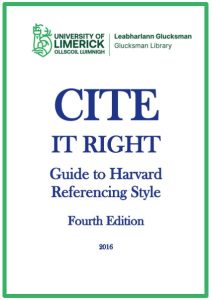Citing & Referencing
Harvard Style of Citing and Referencing
Harvard is a very popular citing and referencing style used in many disciplines including some of the sciences, social sciences, and business. Unlike many of the other styles there is no one authority who manage the Harvard style and this has led to many different versions of Harvard being developed, which can be confusing. Harvard (UL) is a locally popular version of Harvard used by many disciplines in the University of Galway. Check with your instructor regarding the specific requirements for your work and remember to be consistent with your formatting throughout your document.
A comprehensive guide to the Harvard (UL) style is available, click on link below to access this.
Guide to Harvard Referencing Style (UL)
Click on the below for examples of Harvard (UL) citing and referencing applied to a variety of sources.
Book
Book with one author:
In-text citation: (Buckroyd 1996)
Reference list entry:
Buckroyd, J. (1996) Eating your heart out: understanding and overcoming eating disorders, 2nd ed., London: Vermilion.
Book with two authors:
In-text citation: (Mankiw and Taylor 2023)
Reference list entry:
Mankiw, N.G. and Taylor, M.P. (2023) Economics, 6th ed., Andover: Cengage.
Book with more than two authors:
In-text citation: (Schuur et al. 2016)
Reference list entry:
Schuur, E.A.G., Druffel, E.M. and Trumbore, S.E. (2016) Radiocarbon and climate change : mechanisms, applications and laboratory techniques, Switzerland: Springer.
Journal Article
Journal article with one author:
In-text citation: (Lyons 2009)
Reference list entry:
Lyons, J.R. (2009) ‘Atmospherically-derived mass-independent sulfur isotope signatures, and incorporation into sediments’, Chemical Geology, 267(3), 164-174, available: http://dx.doi.org/10.1016/j.chemgeo.2009.03.027.
Journal article with two authors:
In-text citation: (Ashenfelter and Storchmann 2010)
Reference list entry:
Ashenfelter, O. and Storchmann, K. (2010) ‘Using hedonic models of solar radiation and weather to assess the economic effect of climate change: the case of mosel valley vineyards’, The Review of Economics and Statistics, 92(2), 333-349, available: http://dx.doi.org/10.1162/rest.2010.11377.
Journal article with more than two authors:
In-text citation: (Scarcella et al. 2021)
Reference list entry:
Scarcella, I., Michelazzo, L. and McCabe, P. (2021) ‘A pilot single-case experimental design study of rapid syllable transition treatment for Italian children with childhood apraxia of speech’, American Journal of Speech-Language Pathology, 30, 1496-1510, available: http://dx.doi.org/10.1044/2021_AJSLP-20-00133.
Website
In-text citation: (Kingspan 2023)
Reference list entry:
Kingspan (2023) Research reveals stagnation of retrofit rates, available: https://www.kingspangroup.com/en/news-insights/global-retrofit-index-2023/ [accessed 17 May 2024].
Report
In-text citation: (National Parks & Wildlife Service and Vincent Wildlife Trust 2022)
Reference list entry:
National Parks & Wildlife Service and Vincent Wildlife Trust (2022) Lesser horseshoe bat species action plan 2022-2026, Dublin: National Parks and Wildlife Service, available: https://www.npws.ie/sites/default/files/publications/pdf/Lesser%20Horseshoe%20Bat%20Species%20Action%20Plan%202022-2026.pdf [accessed 17 May 2024].
Social Media
In-text citation: (Chester Beatty 2024)
Reference list entry:
Chester Beatty (@CBL_Dublin) (2024) Join us this summer to view one of our most exquisite medieval books! Exhibition opens 24 May. https://rb.gy/gkzydv #lovedublin #summerindublin #keepdiscovering #MedievalManuscripts #FillYourHeartWithIreland [X], 15 May 15:35, available: https://x.com/CBL_Dublin/status/1790752845882384891 [accessed 17 May 2024].
Blog Post
In-text citation: (Bishop 2012)
Reference list entry:
Bishop, D. (2012) ‘How to bury your academic writing’, BishopBlog, 26 Aug, available: http://deevybee.blogspot.com/2012/08/how-to-bury-your-academic-writing.html [accessed 17 May 2024].


